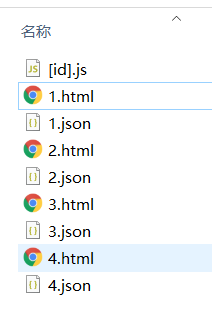前言
next可以实现服务端渲染,也就是在服务端就就获取数据生成一个html页面到客户端,那么怎么实现呢?我们现在做个小案例看看效果,默认各位都是有看过next教程的哈
案例需求
页面
- 一个列表页
- 一个详情页
接口
- 列表接口
- 详情接口
案例实现
很简单就3个步骤
1、首先创建一个next官方脚手架项目
npx create-next-app
2、创建文件
- 在pages目录下创建一个
list页面,一个details页面 - 在api目录下创建一个
list接口,一个details接口
// 目录结构
...
pages
| |---list.js
| |---details
| |---[id].js
| |---api
| |---list.js
| |---details.js
...
3、代码实现
- api里的list接口代码
const data = [
{
id: '1',
title: '测试内容1',
},
{
id: '2',
title: '测试内容2',
},
{
id: '3',
title: '测试内容3',
},
{
id: '4',
title: '测试内容4',
},
];
export default (req, res) => {
res.statusCode = 200;
res.json(data);
};
- api里的details接口代码
const data = [
{
id: '1',
title: '测试内容1',
},
{
id: '2',
title: '测试内容2',
},
{
id: '3',
title: '测试内容3',
},
{
id: '4',
title: '测试内容4',
},
];
export default (req, res) => {
res.statusCode = 200;
let list = data.filter((el) => el.id === req.query.id);
if (list.length > 0) {
res.json(list[0]);
} else {
res.json({});
}
};
- page下的list页面
import fetch from 'node-fetch';
import Link from 'next/link';
const list = (props) => {
const { data } = props;
return (
<ul>
{data.map((el) => (
<li key={el.id}>
<Link href="/details/[id]" as={`/details/${el.id}`}>
<span>详情 {el.id}</span>
</Link>
</li>
))}
</ul>
);
};
export default list;
export const getServerSideProps = async () => {
const res = await fetch('http://localhost:3000/api/list');
const data = await res.json();
return {
props: { data },
};
};
- page下的details页面,在这里有两个重点需要提示一下
- 1、注意一下详情页的写法

- 2、这里的渲染有两种方案,分别是静态生成
getStaticPaths & getStaticProps和动态渲染getServerSideProps。文档最后让大家看看他们的区别
- 1、注意一下详情页的写法
静态生成代码
const Details = function (props) {
const { data } = props;
return <div>{data.title}</div>;
};
export default Details;
export async function getStaticPaths() {
const res = await fetch('http://localhost:3000/api/list');
const data = await res.json();
// 静态生成在build构建的时候,会根据这里的id生成多个js文件
const paths = data.map((el) => ({ params: { id: el.id } }));
return { paths, fallback: false };
}
export async function getStaticProps({ params }) {
const res = await fetch(`http://localhost:3000/api/details?id=${params.id}`);
const data = await res.json();
return { props: { data } };
}
动态渲染代码
const Details = function (props) {
const { data } = props;
return <div>{data.title}</div>;
};
export default Details;
export async function getServerSideProps({ query: { id } }) {
const res = await fetch(`http://localhost:3000/api/details?id=${id}`);
const data = await res.json();
return {
props: { data },
};
}
好了,启动后输入 http://localhost:3000/list试试效果吧
静态生成和动态渲染
最后给大家看看这两种渲染方案的主要区别吧,每次build前删除原打包文件。 我们看看build后的details页面目录
- 静态生成方案
它在build完成后,会生成很多子页面,说实话,假如页面超级多,我觉得打包出来包会大很多。当然,详情页的访问肯定会很快,毕竟请求的就是静态页面嘛

- 动态渲染
这个就没啥好说的,写的啥,打包出来就是啥。访问的时候,需要在服务端进去接口请求























 8563
8563











 被折叠的 条评论
为什么被折叠?
被折叠的 条评论
为什么被折叠?








